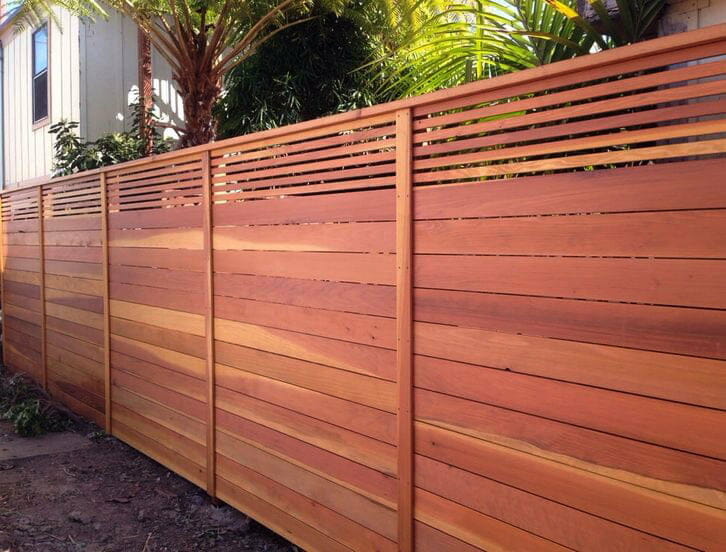A redwood fence is renowned for its natural beauty. Given that it’s made from a type of wood known for its durability, it’s logical to assume it would be long-lasting. But, one might ask, how long can a typical redwood fence be expected to last?
Redwood fencing can last up to 25 years with little to no maintenance. It can easily last up to over 30 years with proper maintenance.
Here is everything that you need to know about redwood fences and their longevity.
Why does redwood fencing last so long?
It lasts so long because it has tannins, acids, and other natural oils that help to protect it. It is also highly dense. And has a unique cell structure.
All of these things combine to help to shield it from:
- Moisture infiltration
- Termite and pest damage
- Warping and splitting due to temperature changes
- Physical damage
Since these are the main causes of damage for almost any wood fence, the fact that redwood has natural protection against them usually goes a long way toward guaranteeing a long lifespan.
How do you prolong the lifespan of your redwood fence?
You can easily get over 2 decades’ worth of value from a redwood fence with little to no maintenance. However, if you want to get a wooden fence to last longer, there are a few things that you should do.
Clean it
Dirt and debris don’t just ruin the beautiful appearance of redwood. They can also trap moisture. This then leads to extended moisture exposure. With time, this will accelerate the rate at which the fence wears out.
To prolong the lifespan of your fence, and almost any other wood fence, you will need to clean the fence regularly.
You should:
- Use a putty knife to remove debris from seams, gaps, and corners.
- Use a leaf blower to remove any remaining debris.
- Wash the fence with soap and water.
To remove any stubborn stains, mildew, or grease, you may have to use diluted bleach, a TSP mixture, or a specialized wood cleaner. Using a brush, instead of a cloth, may also help to remove stubborn stains.
Repair it
Dents, cracks, missing fasteners, and rusting nails are just a few of the problems that will develop over time. You should fix them as soon as they show up. Failing to do so immediately can cause the problem to spread.
Therefore, you should replace any missing fasteners as soon as possible. Reinforce loose or leaning boards. And remove rusted nails.
Stain it
A good quality stain will protect the wood from moisture infiltration. And if you use a transparent stain, you can give the redwood extra protection without necessarily having to compromise its appearance.
You can also give it better protection by applying a semi-transparent stain. Such a stain will not only shield it from moisture infiltration, but also protect it from the damaging effects of UV rays.
The added protection that the fence will get from a high-quality stain will have a significant effect on its lifespan. However, you will have to re-stain the fence after every couple of years so as to guarantee the effectiveness of this extra protection.
Create separation
If you have vines or shrubs growing next to your fence, you should trim them. Doing so is important as this vegetation tends to:
- scratch off the protective layer of the fence — be it a stain or paint
- trap moisture, and this constantly exposes the fence to moisture
- attract pests and other harmful animals that may cause physical damage
- ruin the appearance of the fence by depositing leaves and other debris on the fence
Since vines, shrubs, and plants that grow next to your fence can damage it, regular trimming can effectively prolong your fence’s lifespan.
Does redwood need to be treated?
No, redwood doesn’t need to be treated.
It can last for up to 25 years without treatment because of its tannins, oils, and unique cell structure. A combination of these factors makes it natural:
- resistant to rotting
- resistant to termite infestations
- good at handling moisture exposure
- fire resistant, and
- resistant to warping, splitting, and bulging
However, this does not mean that treating redwood is pointless.
While it may not be beneficial to treat it against termites, staining and sealing redwood will significantly improve its lifespan. It will arm the fence with extra layers of protection against the sun and moisture, and this will definitely go a long way toward increasing its longevity.
Does redwood last longer than cedar?
Yes, redwood lasts longer than cedar.
It is denser. It has stronger concentrations of tannins and oils. And it has a superior cell structure that gives it better protection against moisture infiltration, termite attacks, rotting agents, and fire.
Therefore, redwood fencing tends to last longer than cedar fences.
Is redwood good for fencing?
Yes, redwood is good for fencing.
It contains acids and natural oils that shield it from moisture infiltration. These oils and acids also repel termites and other pests.
Benefits of using it for fencing
These qualities make it a great fencing material because it means that the fence will be able to withstand the harsh external environment. The fence will be:
- less likely to become warped
- naturally resistant to termites and other harmful pests
- naturally resistant to rotting agents
- last really long
No need for regular maintenance
And since the fence will have these qualities naturally, a homeowner won’t have to worry about regular maintenance.
All these things combine to make redwood one of the best fencing materials in the market. This is so especially when you consider the fact that it isn’t treated with chemicals – like pressure treated wood.
The only downside to using redwood is that it isn’t as readily available as other fencing options like cedar. And so unless you live on the Northern California Coast, you are likely to have a hard time getting your hands on it.
It is also relatively more expensive. This usually limits its use. And it can make using it uneconomical, especially when you compare it to the cost of typical wooden fences..
FAQ's
Yes, redwood lasts longer than cedar fences.
Why?
Because redwood, from giant redwood trees, is denser than cedar. It also has a higher concentration of acids and natural oils that give it a healthy measure of resistance against rotting, pests, fire, and moisture infiltration.
No, a redwood fence does not need to be sealed.
Structure, density, and oils
Thanks to its unique cell structure, density, and protective oils, the fence has an elaborate protective system that does what a sealer normally does. Therefore, when compared to the average wood fence, it is better at withstanding moisture, sun, and extreme temperature exposure without getting damaged.
However, this does not mean that you shouldn’t seal your redwood fence.
Sealing helps
While it doesn’t need it, it can definitely benefit from being sealed. This is because the sealer will be an extra layer of protection that the harmful elements will have to get through before they can come in contact with the wood.
Therefore, sealing will help to increase the lifespan of the redwood fence.
You stain your fence at least once every 3 years. Staining it as often as after every 2 years is ok. And so is taking 4 years in-between stains.
You have to re-stain periodically because the stain wears off with time. And so if you used a stain to enhance the color of lighter redwood timber fence planks, the color may start to fade with time. And so re-staining may be necessary to enhance its appeal.
The stain may also get scratched and chipped. And so you will have to refresh the protective coating on a regular basis if you want to prolong the lifespan of your fence.
No, you shouldn’t paint your redwood fence.
Covers the attractiveness
While there is nothing wrong with painting it, you shouldn’t do it because you will be messing with one of the redwood’s best features: its beauty and appearance.
Unlike a typical wooden fence, a redwood fence has an excessively attractive reddish color. It also has a beautiful grain profile. And it always gives a home a beautiful natural appeal.
Painting it will mean covering all this behind a coat of paint. It almost makes using redwood pointless.
Naturally has what paint provides
Furthermore, the redwood fence doesn’t really need what painting provides. It is already aesthetically pleasing. And it is naturally resistant to moisture and other weather elements.
Better alternatives
There is also the fact that you have superior options like sealing and staining. These options give the redwood fence all the protective benefits of painting without hiding its beauty. This is because there are transparent and semitransparent stains and sealants.
Yes, you can use redwood as fence posts.
It is strong, durable, moisture-resistant, and pest-repellent. This means that, unlike other fencing materials like pressure treated wood, cedar, and douglas fir, it won’t have trouble bearing the weight of the fence. It also won’t succumb to moisture, rotting, and termite attacks.
You should choose cedar for fencing.
Redwood is superior
You should choose it even though redwood is superior in terms of raw strength, stability, resistance to moisture, ability to repel pests, and aesthetic appeal.
But…
Why? Because cedar is more readily available. When compared to redwood, it is very affordable. And since it has enough of the good qualities of redwood, cedar wood fences typically provide better value for money.
Yes, staining makes a wooden fence last longer. This is because a stain essentially seals the wood fibers and makes it less likely to allow moisture to infiltrate it. And in cases where one is using a transparent stain, he or she will get more out of the fence because the stain will shield it from

If you need help installing or fixing a fence, you should use HomeGardenGuides.com. The site offers a free service that allows you to easily explore and rate the quality of services that fencing experts in your area provide.
The service that they provide quickly matches you with the top-voted local expert fence repair services.
Using the website, you can get 3 estimates fast by real certified experts in your area in just 2 minutes.
Here is how it works.
- You scroll to the top of the page and enter your Zip code.
- Answer questions about your fencing needs and preferences
- Your details will be forwarded to three local experts.
- You will then receive a price estimate – in writing – for the job and some friendly advice.
IMPORTANT: There is no obligation to hire. This is a free tool and service to be used at your pleasure, whether you just need more information on fixing a fence or you need an expert’s advice.









